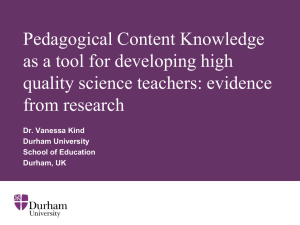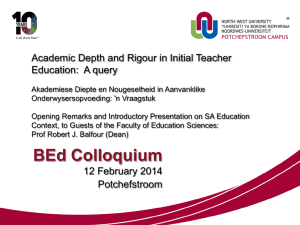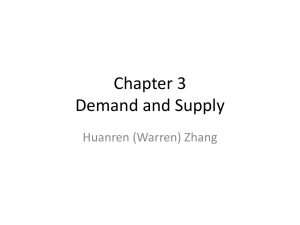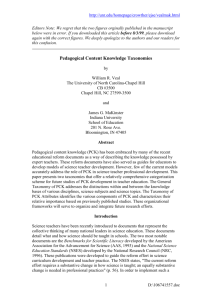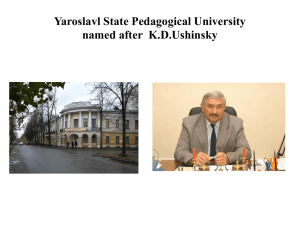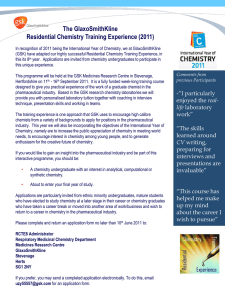Building PCK Incrementally in A Topic Based Pre-Service
advertisement
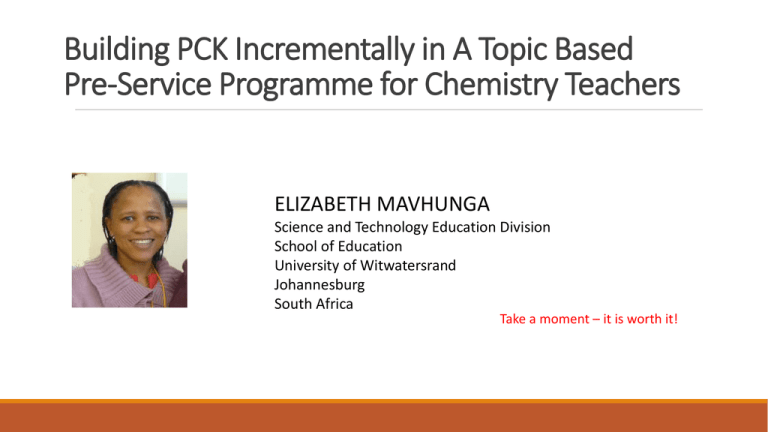
Building PCK Incrementally in A Topic Based Pre-Service Programme for Chemistry Teachers ELIZABETH MAVHUNGA Science and Technology Education Division School of Education University of Witwatersrand Johannesburg South Africa Take a moment – it is worth it! Context The study is part of a larger Project, pioneered by Prof. Marissa Rollnick exploring Pedagogical Content Knowledge (PCK) of Secondary School chemistry and physics teachers in the greater Johannesburg area, South Africa. In this study, I specifically concentrated on the development of PCK in specific chemistry topics in pre-service teachers. I explored concrete ways of incrementally building PCK in chemistry topics in a pre-service programme. BACKGROUND Teacher educator programmes across the globe generally aim to develop pedagogical competencies needed for effective teaching. In science education, the competencies include the development of Pedagogical Content Knowledge (PCK) to assist pre-service teachers to both plan and enact in ways that increase effective teaching and enhanced learning (Park & Oliver, 2008; Mehmet & Zubeyde, 2014). PCK was first introduced in education by Shulman (1986) as unique to teachers requiring a blend of content and pedagogical knowledge that is specific to topics. he defined PCK as the “understanding of how particular topics, problems, or issues are organised, represented, and adapted to the diverse interests and abilities of learners, and presented for instruction” (p. 8). In my view, similar to Ball et al. (2008), PCK provides the field of education with a perspective that brings content knowledge (CK) and thinking about its teaching onto a common plane. CHALLENGE In spite of the agreement, implementation in teacher preparation programmes in ways that develop pre-service teachers’ capabilities to plan and enact richly in their teaching of science topics remains a challenge. Some of the reasons are related to: ◦ The diverse backgrounds that pre-service teachers bring in terms of their content knowledge, beliefs, and experiences (Mehmet & Zubeyde, 2014). ◦ Another reason of particular interest to this paper, is that teacher educators do not have time to model lessons related to every core curriculum topic in which they could demonstrate best practices (Grossman, 2011). Purpose The purpose of this study is to explore ways of assisting pre-service teachers incrementally build PCK across chemistry topics during the traditional time registered in a teacher development programme. Central to the approach for the development of PCK in topics discussed in this paper is the ability to reason and transform CK. Reasoning for teaching purposes According to Shulman, the development of pedagogical reasoning in teachers is important as it is as much part of teaching as is the actual practice itself (Shulman, 1987). Reasoning through concepts of a topic for teaching is beyond the knowledge of the conceptual facts. It extends into knowledge about the structure, the most important aspects of the topic, the connections between concepts and ways of representations of concepts among other things. When the excellence of teaching is evaluated, the reasons behind a teacher’s decisions and choices are critical insights (Jang, 2011). This means it is beneficial to influence the development of pedagogical reasoning in pre-service teachers that can be implored to justify teaching actions in a classroom (Shulman, 1987). The development of Topic Specific PCK in Preservice The topic specific nature of PCK has been attested to by many empirical studies in science education (e.g.Loughran, Berry, & Mulhall, 2004). In a previous paper (Authors, 2013) we introduced the construct Topic Specific PCK (TSPCK) defining PCK in a specific topic. We argued that its value lies in its exclusive focus on a topic, in particular, the capacity to transform concepts within a topic. The study further showed that pre-service teachers, in line with Nilsson and Loughran (2011), can develop this capacity by focusing on the nature of knowledge components of TSPCK to elicit specific knowledge about teaching the content knowledge thereby transforming it and significantly improve their PCK in a topic. PCK developed in this manner, according to Park and Oliver (2008) refers to espoused or planned PCK. Good teaching is not only about knowledge but also the capability to reason soundly about teaching. Sound reasoning by teachers requires both a process of thinking about their actions and a sufficient repertoire of content, principles and experience from which to reason Shulman (1987). While pre-service teachers may not have experience to draw from, we therefore explored, in this paper the feasibility of increasing the potential to transform concepts across core topics in chemistry in the meantime while pre-service teachers are under a registered programme. Method The study employed a mixed method (MM) research design. It was located in the Physical Science methodology class, with 38 chemistry pre-service teachers in their third (3) year of study towards a teacher qualification - B Ed degree. This class was a mix of pre-service teachers who are majoring in physical science and those who will not continue with chemistry into the fourth year as they chose to major in mathematics. In our view, it is important to expose this class to discussions about transformation of CK as in our country (South Africa) often Secondary School mathematics teachers are mutely expected to teach physical science at the same senior grades as mathematics, despite the fact they did not major in the subject. A note: Physical science refers to a course comprised of chemistry and physics as equal components. intervention The intervention happened over a period of six (6) weeks, with three 50 minute sessions a week. The topic Particulate Nature of Matter was used to discuss each of the five component according to the sequence below. Component Intervention Student prior knowledge Discussions on widely researched conceptions and common misconceptions on particle nature of matter found in the literature. Emphasis was placed on awareness and recommended teaching strategies to confront misconceptions. Curricular saliency Identification of the big ideas and the corresponding subordinate concepts in a topic; sequencing for scaffolding learning; awareness of the background concepts needed before teaching the topic and knowing what is most important to understand in topic. Why it is difficult to teach Exploration of gate keeping concepts considered difficult to learn, and not necessarily misconceptions. Introduction of the three levels of explanations in chemistry at macroscopic, symbolic and sub-microscopic level. Emphasis was placed in using all three representations in explaining a phenomenon. Emphasis on conceptual strategies rather than general pedagogy and logistics. Knowledge of representations Conceptual Teaching strategies Data collection The data collected constituted students submitted exam equivalent tasks. The tasks were administered 6 weeks after the completion of the intervention, corresponding to the end of semester examination. The exam equivalent tasks required pre-service teachers to use the learnt pedagogical transformation process to engage with a novel topic – Chemical Equilibrium which is generally perceived to be difficult and abstract. The topic was considered novel in sense that it was not discussed in the methodology course. The exam equivalent tasks were considered as a vignette prompting natural open ended responses that reflect engagement of the topic through the five TSPCK knowledge components. Structure of the vignettes There were two major teacher tasks. Task 1 Pre-service teachers to design an evaluation schedule and use it to evaluate a recorded video lesson on chemical equilibrium looking for evidence of TSPCK. The recorded lessons was an extract form a lesson where a teacher introduced the concept of dynamic chemical equilibrium. Pre-service teachers were requested to capture their evaluations using ‘extracted episodes of evidence’ from the recorded lesson and accordingly provide reasons for their judgements. Responses from this task shared light into whether pre-service teachers could recognize practical moments where TSPCK is displayed in the topic, and whether they could suggest improvements where found limited. Structure of the vignettes Task 2 The second major task required the written identification of the big ideas of the topic of the recorded lesson along the lines of a Content Representation (CoRe) (Loughran et al., 2004). The task further contained two sub-tasks, requiring pre-service teachers: (i) to map back the content of the recorded lesson to the suggested big ideas (ii) develop a lesson plan, showing pedagogical transformation of the CK of a lesson to conceptually and logically succeed the recorded lesson. ANALYSIS The thick qualitative responses collated from the two tasks in the exam equivalent tasks were scored, using a TSPCK rubric (Mavhunga & Rollnick, 2013). An extract is show below: ANALYSIS The rubric generates a minimum overall score of 5 and a maximum overall score of 20. The scores generated from using the TSPCK rubric were translated into probability person measures using a Rasch statistical model (Winsteps) for identification of the rank order of difficulty of the TSPCK components (Boone & Rogan, 2005). FINDINGS In order to develop an overview of the performance of the group we presented in a graphical form (Figure below) the averaged individuals’ TSPCK scores, obtained across the five TSPCK components according to the TSPCK rubric. 5 TSPCK Qualitative Scores 4 3 2 1 0 Participants Figure 1: Averaged individual qualitative TSPCK scores Limited Table 1: Frequencies at which each category of the TSPCK rubric was scored for each of Learner Prior Knowledge the TSPCK components Curricular Saliency What is Difficult to understand ****** ****** Representations Teaching Strategies * Basic Developing Exemplary ****** * ****** ****** ****** ** ****** ***** ****** ****** ****** ** ****** ****** ****** ****** **** ****** ****** ** ** ****** ****** ****** ****** ****** *** ***** ****** ****** ****** ** ****** ****** ***** The table shows a high frequency of scores in the ‘developing’ category in most of the components of TSPCK confirming and the observation in Figure 1 A ‘developing’ level of TSPCK means that the pre-service teachers have in terms of the five components a reasonable sense of curricular saliency in the new topic. Specifically that they can recognize and suggest core concepts that are most important and those that are peripheral (Geddis, 1993). This criterion was met by the majority of the pre-service teachers through their extracted extracted episodes of evidence’ examples of such extracts are those of students Mahamu and Lebo below: “Emphasis should be put on why the equilibrium is said to be ‘dynamic’. The teacher [in the recorded video lesson] did not explain thus far. Also the teacher failed to put emphasis on that chemical equilibrium may be reached in a closed system”. Mahamu’s written response “The teacher managed to explain to the learners that the product and reactants will not be finished in the reaction but did not mentioned that the reaction is reversible and even when he wrote the chemical equation, he used the incorrect arrow that does not represent a reversible reaction.” Lebo’s written response The extracts indicate evidence of understanding by the pre-service teachers of the most important concepts related to the big idea on dynamic chemical equilibrium. This is beyond mere knowing of the concepts but knowing what is most important to explained when. Another example of what a ‘developing’ level of TSPCK is seen in the extract on the component of Conceptual Teaching Strategy. This component of TSPCK naturally pulls the other components onto a single plane with opportunities for demonstration of the interactions between the components: The extract below has been lifted from a suggested lesson plan, where pre-service teachers were requested to suggest a lesson that would conceptually succeed the recorded one and indicate what they would consider in reasoning about its teaching. Student Lebo proposed a lesson sequence on factors affecting equilibrium, in particular temperature. ‘I will starts the lesson by recapping with learners what the concepts endothermic and exothermic reactions mean and how they are illustrated in a chemical equation using change of enthalpy. I will then explain the Le Châtelier’s principle and write on the board an example an equation at equilibrium and explain the reverse and the forward reaction as I write. I will do an experiment of NO2/N2O4 system illustrating effect of temperature at equilibrium. Following a discussion on the experiment in a manner that involves learners, I will draw on the board two microscopic representations of the NO2/N2O4 molecules at equilibrium at different temperatures, linking to the symbolic representation in a form of chemical equation. I will play around (in a form of questions) with the concepts of endothermic and exothermic at the condition of a changing temperature when system at equilibrium.’ A striking feature of the extract is that it is built on manipulation of considerations about the CK of the topic. The suggested teaching strategy of using experiments to conceptually demonstrate the effects at equilibrium is conceptual and in line with those suggested in the literature for the topic of chemical equilibrium (Van Driel & Graber, 2002). The reference to endothermic and exothermic reactions at the beginning of the suggested lesson demonstrates awareness of an aspect of curricular saliency – knowledge of pre-concepts needed prior to the discussion of a concept. These pre-concepts, in turn, are important in explaining the changes at temperature due to temperature. There is a further indication of the knowledge and planning for potential common misconceptions students hold about dynamic equilibrium where Lebo emphasizes the issue of reversible reactions. The indication for use of representations at microscopic level linked to symbolic presentations of the reactions further displays the transformation of the concepts discussed. The issue of exothermic and endothermic is repeated and re-emphasized at the end of the lessons, in a form of questions, with reference to the effect of temperature at equilibrium. This act of emphasizing what is core and important for the concepts in discussion is a crucial aspect of curricular saliency. Here we see consideration and pulling together of the other TSPCK components to create depth in the understanding by learners. The extract demonstrates transformation of CK by reasoning through the components of TSPCK. Conclusion The findings show that by using a framework of the knowledge components that transforms CK, preservice teachers are able to apply the framework to transform concepts in a topic and therefore improving their planned PCK. This improvement happens in a new topic outside the intervention. This finding provides hope for increasing the number of core chemistry topics where pre-service teachers can potentially improve their planned PCK prior to teaching. While this improvement is PCK at a planning level, thinking about the teaching of the topic is important and desirable from the point of influencing and enriching the grounds from which the teacher may base reasons for actions in class Shulman (1987). Secondly, the findings are encouraging as a response to the challenge of limited time by teacher development programmes for building PCK in many other topics of the discipline as the process of explicitly discussing components of TSPCK in a topic is laborious. This outcome has implications on teacher preparation programmes. The findings open a potential path for building PCK increamentally in the key topics of the chemistry discipline. The approach may also be explored in other disciplines of science. Thanking you, for taking time reading my presentation Contact Details: Elizabeth.Mavhunga@wits.ac.za

